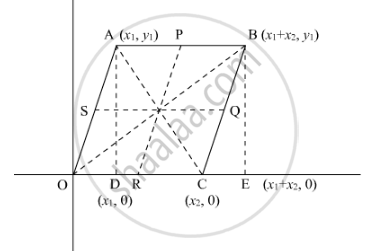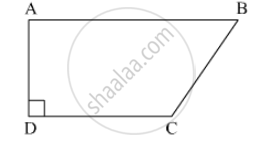Advertisements
Advertisements
Question
Prove that the lines joining the middle points of the opposite sides of a quadrilateral and the join of the middle points of its diagonals meet in a point and bisect one another
Solution
Let us consider a Cartesian plane having a parallelogram OABC in which O is the origin.
We have to prove that middle point of the opposite sides of a quadrilateral and the join of the mid-points of its diagonals meet in a point and bisect each other.

Let the co-ordinate of A be `(x_1,y_1)`. So the coordinates of other vertices of the quadrilateral are- O (0, 0); B`(x_1+x_2,y_1)`; C`(x_2,0)`
Let P, Q, R and S be the mid-points of the sides AB, BC, CD, DA respectively.
In general to find the mid-point p(x,y) of two points`A(x_1,y_-1)`and B`(x_2,y_2)` we use section formula as,
`P(x,y)=((x_1+x_2)/2,(y_1+y_2)/2)`
So co-ordinate of point P,
`=((x_1+x_2+x_1)/2,(y_1+y_-2)/2)`
`=((2x_1+x_1)/2,y_1/2)`
Similarly co-ordinate of point R,
`=(x_2/2,0)`
Similary co-ordinate of point S,
`=(x_1/2,y_1/2)`
Let us find the co-ordinates of mid-point of as,
`(((2x_1+x_2)/2+x_2/2)/2,y_1/2)`
`=((x_1+x_2)/ 2,y_1/2)`
Similarly co-ordinates of mid-point of Qs,
`=((x_1+x_2)/2,y_1/2)`
NOw the mid-pont of diagonal AC,
`=((x_1+x_2)/2,y_1/2)`
Similarly the mid-point of diagonal OA,
`((x_1+x_2)/2,y_1/2)`
Hence the mid-points of PR, QS, AC and OA coincide.
Thus, middle point of the opposite sides of a quadrilateral and the join of the mid-points of its diagonals meet in a point and bisect each other.
APPEARS IN
RELATED QUESTIONS
In each of the following find the value of 'k', for which the points are collinear.
(8, 1), (k, -4), (2, -5)
The area of a triangle is 5. Two of its vertices are (2, 1) and (3, −2). The third vertex lies on y = x + 3. Find the third vertex.
The coordinates of the point P dividing the line segment joining the points A (1, 3) and B (4, 6) in the ratio 2 : 1 are:
In ☐ABCD, l(AB) = 13 cm, l(DC) = 9 cm, l(AD) = 8 cm, find the area of ☐ABCD.

Using integration, find the area of the triangle whose vertices are (2, 3), (3, 5) and (4, 4).
In a triangle ABC, if `|(1, 1, 1),(1 + sin"A", 1 + sin"B", 1 + sin"C"),(sin"A" + sin^2"A", sin"B" + sin^2"B", sin"C" + sin^2"C")|` = 0, then prove that ∆ABC is an isoceles triangle.
If the points (3, -2), (x, 2), (8, 8) are collinear, then find the value of x.
The points (0, 5), (0, –9) and (3, 6) are collinear.
The points A(2, 9), B(a, 5) and C(5, 5) are the vertices of a triangle ABC right angled at B. Find the values of a and hence the area of ∆ABC.
Find the missing value:
| Base | Height | Area of Triangle |
| 22 cm | ______ | 170.5 cm2 |
